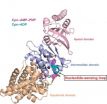(Press-News.org) For decades, scientists have understood that there is a genetic component to intelligence, but a new Harvard study has found both that most of the genes thought to be linked to intelligence are probably not in fact related to it, and identifying intelligence's specific genetic roots may still be a long way off.
Led by David I. Laibson '88, the Robert I. Goldman Professor of Economics, and Christopher F. Chabris '88, PhD '99, Assistant Professor of Psychology at Union College, a team of researchers examined a dozen genes using large data sets that included both intelligence testing and genetic data. As reported in a forthcoming article in the journal Psychological Science, they found that, in nearly every case, the hypothesized genetic pathway failed to replicate. In other words, intelligence could not be linked to the specific genes that were tested.
"It is only in the past 10 or 15 years that we have had the technology for people to do studies that involved picking a particular genetic variant and investigating whether people who score higher on intelligence tests tend to have that genetic variant," said Chabris. "In all of our tests we only found one gene that appeared to be associated with intelligence, and it was a very small effect. This does not mean intelligence does not have a genetic component, it means it's a lot harder to find the particular genes, or the particular genetic variants, that influence the differences in intelligence."
To get at the question of how genes influence intelligence, however, researchers first needed data, and plenty of it.
Though it had long been understood, based on studies of twins, that intelligence was a heritable trait, it wasn't until relatively recently that the technology emerged to allow scientists to directly probe DNA in a search for genes that affected intelligence.
The problem, Chabris said, was that early technology for assaying genes was wildly expensive, meaning that such studies were typically limited to, at most, several hundred subjects, who would take IQ tests and provide DNA samples for testing.
As part of their study, Chabris and colleagues relied on several pre-existing data sets – a massive study of Wisconsin high school graduates that began in the 1950s, the Framingham Heart Study, and an ongoing survey of all twins born in Sweden – to expand that subject pool from a few hundred to many thousands.
"What we want to emphasize is that we are not saying the people who did earlier research in this area were foolish or wrong," Chabris said. "They were using the best technology they had available. At the time it was believed that individual genes would have a much larger effect – they were expecting to find genes that might each account for several IQ points."
To identify genes that might play a role in intelligence, previous researchers used the "candidate gene approach," which required identifying a gene that was already linked with a known biological function – such as Alzheimer's disease or the production of a specific neurotransmitter. If people who scored high on intelligence tests shared a particular variant of that gene, it was believed, that demonstrated the gene's role in intelligence.
"These were reasonable hypotheses," said study co-author Daniel J. Benjamin '99, PhD '06, Assistant Professor of Economics at Cornell University. "But in retrospect, either the findings were false positives or the effects of the genes are much, much smaller than anyone had anticipated."
Chabris, however, emphasized that the results don't point to the idea that the dozen genes examined in the study play no role in intelligence, but rather suggest that intelligence may be tied to many genes, and the ways in which they interact.
"As is the case with other traits, like height, there are probably thousands of genes and their variants that are associated with intelligence," he said. "And there may be other genetic effects beyond the single gene effects – there could be interactions between genes, there could be interactions between genes and the environment. What our results show is that the way researchers have been looking for genes that may be related to intelligence – the candidate gene method – is fairly likely to result in false positives, so other methods should be used."
INFORMATION: END
PHILADELPHIA -- Would you be able to find an automated external defibrillator if someone's life depended on it? Despite an estimated one million AEDs scattered around the United States, the answer, all too often when people suffer sudden cardiac arrests, is no.
In a Perspective piece published online this week in the journal Circulation: Cardiovascular Quality Outcomes, two researchers from the Perelman School of Medicine at the University of Pennsylvania outline the tremendous potential associated with greater utilization of AEDs in public places and a method to find ...
LOS ALAMOS, New Mexico, February 24, 2012—A multinational team of scientists has developed a process for creating glass-based, inorganic light-emitting diodes (LEDs) that produce light in the ultraviolet range. The work, reported this week in the online Nature Communications, is a step toward biomedical devices with active components made from nanostructured systems.
LEDs based on solution-processed inorganic nanocrystals have promise for use in environmental and biomedical diagnostics, because they are cheap to produce, robust, and chemically stable. But ...
CLEMSON — A study of X-rays emitted a long time ago in a galaxy far, far away has unmasked a stellar mass black hole in Andromeda, a spiral galaxy about 2.6 million light-years from Earth.
Two Clemson University researchers joined an an international team of astronomers, including scientists at Germany's Max Planck Institute for Extraterrestrial Physics, in publishing their findings in a pair of scientific journals this week.
Scientists had suspected the black hole was possible since late 2009 when an X-ray satellite observatory operated by the Max Planck Institute ...
NEW YORK – February 24, 2012 – A forthcoming article in the Journal of Consumer Research by Professor Michel Tuan Pham, Kravis Professor of Business, Marketing, Columbia Business School; Leonard Lee, Associate Professor, Marketing, Columbia Business School; and Andrew Stephen, PhD '09, currently Assistant Professor of Business Administration, Joseph M. Katz Graduate School of Business, University of Pittsburgh, finds that a higher trust in feelings may result in more accurate predictions about a variety of future events. The research will also be featured in Columbia Business ...
The gold standard for nanotechnology is nature's own proteins. These biomolecular nanomachines – macromolecules forged from peptide chains of amino acids - are able to fold themselves into a dazzling multitude of shapes and forms that enable them to carry out an equally dazzling multitude of functions fundamental to life. As important as protein folding is to virtually all biological systems, the mechanisms behind this process have remained a mystery. The fog, however, is being lifted.
A team of researchers with the U.S. Department of Energy (DOE)'s Lawrence Berkeley ...
Patients with heart disease who took cholesterol-lowering statins were significantly less likely to develop depression than those who did not, in a study by Mary Whooley, MD, a physician at the San Francisco VA Medical Center and a professor of medicine at the University of California, San Francisco.
The study was published electronically in the Journal of Clinical Psychiatry (February 21, 2012).
Whooley and her research team evaluated 965 heart disease patients for depression, and found that the patients who were on statins were significantly less likely to be clinically ...
NEW YORK – February 24, 2012 – A recent study in the Review of Financial Studies proposes a new, valuation-based measure of equity market segmentation. Equity market segmentation occurs when stocks of similar risk in different countries are priced differently. The study, by Columbia Business School Professor Geert Bekaert, Chazen Senior Scholar at The Jerome A. Chazen Institute of International Business at Columbia Business School and the Leon G. Cooperman Professor of Finance and Economics, uncovers the factors that cause variation in market segmentation, both through ...
Prehistoric Eurasian nomads are commonly perceived as horse riding bandits who utilized their mobility and military skill to antagonize ancient civilizations such as the Chinese, Persians, and Greeks. Although some historical accounts may support this view, a new article by Dr. Michael Frachetti (Washington University, St. Louis) illustrates a considerably different image of prehistoric pastoralist societies and their impact on world civilizations more than 5000 years ago.
In the article, recently published in the February issue of Current Anthropology, Frachetti argues ...
Boulder, Colorado, USA - Linear dunes, widespread on Earth and Saturn's moon, Titan, are generally considered to have been formed by deposits of windblown sand. It has been speculated for some time that some linear dunes may have formed by "wind-rift" erosion, but this model has commonly been rejected due to lack of sufficient evidence. Now, new research supported by China's NSF and published this week in GSA BULLETIN indicates that erosional origin models should not be ruled out.
The linear dunes in China's Qaidam Basin have been proposed to have formed as self-extending ...
Boulder, CO, USA - New GSA BULLETIN science published online 24 Feb. includes work on the Chugach Metamorphic Complex of southern Alaska; news and data from the first non-Russian science team to make a helicopter over-flight of Shiveluch volcano in Kamchatka, Russia, after its large 2005 eruption; and a study by a team from the Lamont-Doherty Earth Observatory that proposes a new calibration model for the Eocene segment of the Geomagnetic Polarity Time Scale (GPTS).
Large-scale, short-lived metamorphism, deformation, and magmatism in the Chugach metamorphic complex, ...



